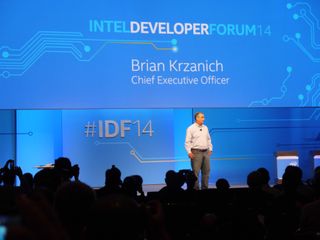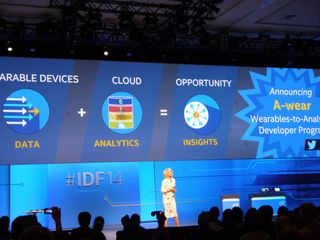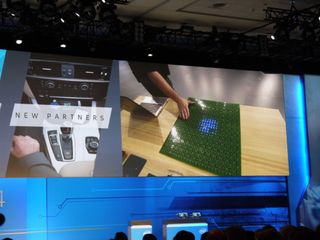Intel IDF 2014 Keynote: From Wearables To Big Data With PCs and Mobile Devices In Between

Krzanich started off by talking about the areas that Intel is focused on for the near future, including the Internet of Things (IoT), wearables, mobile devices (particularly tablets, laptops, and hybrids thereof), the data center, and makers (with its Galileo and Edison development boards).
In describing Intel's wearables endeavors, Krzanich clearly pointed toward a dual-focus on both fashion and usability. The SMS Audio Biosport headphones, which he said he uses, are a new take on a runner's companion wearable. It allows you to monitor your heart rate and listen to your music while it charges itself via your smartphone. The MICA smartwatch (well, bracelet) was a collaboration between Intel and Open Ceremony to create a device that's designed to be physically attractive and stylish. And Fossil, a billion-dollar-plus company, is partnering with Intel to make stylish smart accessories.
For as neat as Intel's wearables may be, it's only passably interesting compared to the other technologies Krzanich and other company heads have in store, and it all starts with the data center.

Diane Bryant took a turn onstage, and she was as direct as possible: "These devices are nothing without a data center," she said. Every single device, from wearables to mobile devices to IoT-connected homes and buildings, is backed by a data center. Intel is trying to harness and process all that big data to not just handle the huge amount of daily tech transactions we make on our devices (currently one trillion per day, just via our smartphones), but also help the medical field and other markets perform better.
She announced that Intel is launching a wearables-to-analytics dev program called "A-wear" that will tie devices on the periphery (in this case, wearables) with big data analytics.
On the PC side, Intel's Kirk Skaugen let us know that the 5th generation of Core processors, SkyLake (the successor to Broadwell) will be coming in the second half of 2015, bringing with it better power efficiency and improved battery life. It will still be on the 14nm process, and you'll see it in everything from high-performance desktop to 2-in-1s. (Even so, Intel is planning for the 10nm process and beyond.)
That 2-in-1 category is actually a key focus for Intel's mobile strategy. Skaugen said that 2-in-1s are the fastest-growing segment of mobile computing, and the company's recently announced Core M processor will underpin a great many of those devices. Core M chips are designed to enable fanless devices that also boast impressive performance, and what Intel appears to be attempting here is almost a hostile takeover of the tablet market.
Stay on the Cutting Edge
Join the experts who read Tom's Hardware for the inside track on enthusiast PC tech news — and have for over 25 years. We'll send breaking news and in-depth reviews of CPUs, GPUs, AI, maker hardware and more straight to your inbox.
Skaugen said that Intel-powered 2-in-1s will offer the best of laptops and tablets (an old trope at this point, to be sure), but the shiny new devices onstage and the promise of Core M performance do appear to lend some credence to his claim. And if they do, and can hit low price points, that may spell trouble for the huge tablet market.
Intel is also pressing on the smartphone segment with its mobile LTE chip (Intel Xmm7260), which delivers 300 mbps/CAT6 performance and should be coming nearly worldwide by the end of the year. It will first appear in the Samsung Galaxy Alpha smartphone.

One of Intel's boldest (but hopefully nearest-to-reality) technologies involves wireless--well, everything. By the end of 2015, Intel hopes to have a reference platform to help eliminate all cables with wireless displays, wireless charging and wireless peripherals, all based on standards. The company demoed a desk equipped with a Rezence device that powered a laptop, a tablet, and a set of Bluetooth earbuds through two inches of wood. The laptop connected wireless and seamlessly with an external display and its mouse and keyboard, too.
Further, Intel wants to do away with passwords. "We have to eliminate passwords. You are your password," said Skaugen. Beginning in 2015, biometrics measured by voice, touch, and 3D camera input should be the way you access your devices. In other words, the interface and your password are linked.
For all the talk of hardware, though, one mustn't forget about the software. Intel's Doug Fisher talked about Intel's efforts to optimize software for Intel architectures to make it easier for developers to create and produce faster. To that end, he announced the Intel Reference Design for Android, a tablet upon which devs can create a complete stack.
He segued into talk of Intel's intriguing RealSense technology, which uses 3D cameras, integrated sensors (such as compass, gyroscope, light, and pressure) and the Intel Context Sensing SDK and Intel RealSense SDK to create natural and immersive interactions, enhanced photography, and scene perception and capture.

RealSense has sounded a bit like vaporware, but today CEO Krzanich revealed that it is a Real Thing. He pulled Michael Dell onstage to show off the first RealSense device, the Dell Venue 8 7000 series (yet a production model), which boasts the Intel RealSense Snapshot Depth Camera.
The impressively thin 6 mm tablet ("World's thinnest," claimed Dell) boasts a 2K resolution with an 8.4-inch UltraHD OLED display and an edge-to-edge screen. It should also have tremendous battery life--Krzanich said that he uses it all the time and only has to charge it every other day--and will be available in early November.
In a live demo, Krzanich showed you can change the focus or easily change the color of a photo you've snapped, and he showed off a feature whereby you can take a picture of an object and the camera will actually measure it for you.
Being the keynote, Intel merely touched on most of the technologies we'll get to see over the next few days. Stay tuned for more coverage from IDF 2014 in San Francisco.
Follow Seth Colaner@SethColaner. Follow us @tomshardware, on Facebook and on Google+.
-
The_Icon I don't understand Nvidia and AMD fanboy but...is it okay if I have fanboyism for Intel.. :PReply
Most Popular




